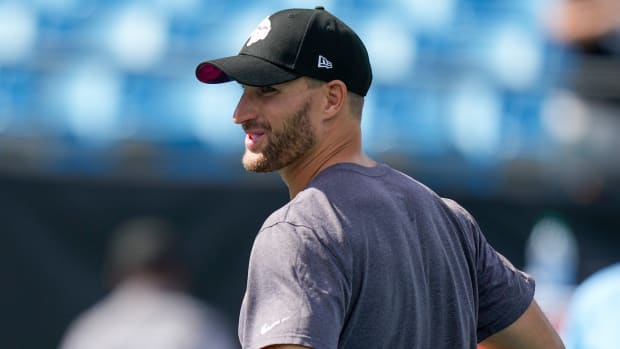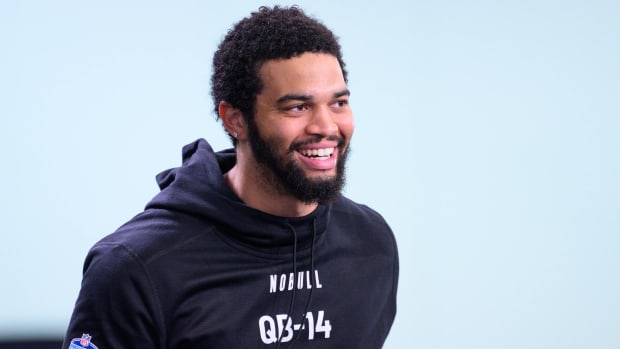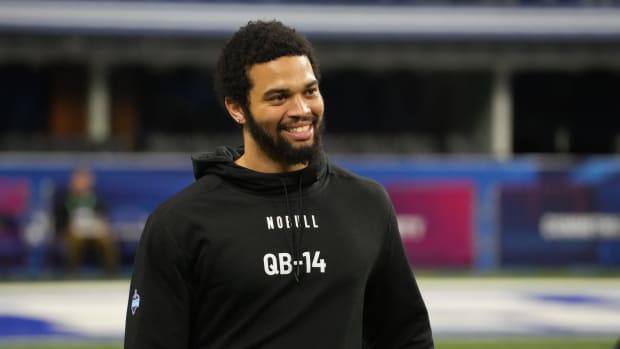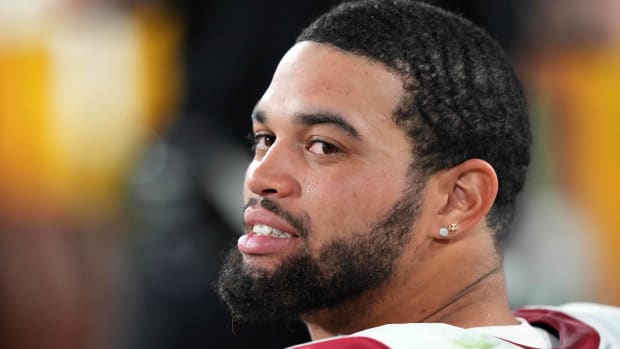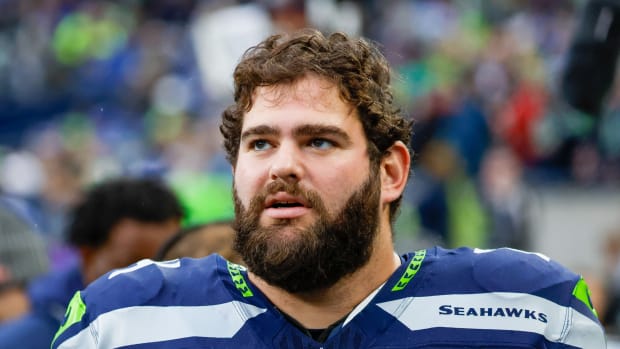Three decades ago former Bears personnel boss Bill Tobin, then working for the Colts, uttered a phrase perhaps more associated with the NFL Draft than probably anything except "the pick is in" or "on the clock."
"Who the hell is Mel Kiper anyway?" Tobin demanded on live television.
"In my knowledge of him, he's never, ever put on a jockstrap," Tobin continued. "He's never been a coach, he's never been a scout, he's never been an administrator, and all of a sudden. he's an expert?'
Kiper had an answer.
"I think it's a typical Colts move," he said. "I mean, here's a team that needs a franchise quarterback, to pass up on Trent Dilfer when all you have is Jim Harbaugh, gimme a break! That's why the Colts are picking second every year in the draft, not battling for the Super Bowl like other clubs in the National Football League."
Ultimately, no one would call Dilfer a smash success. He road possibly the second-best defense in the history of football to a Lombardi Trophy in Baltimore as Tony Banks' substitute after starting four seasons in Tampa.
The player in question by Kiper was the one Tobin took, linebacker Trev Alberts, selected fifth overall for the Colts after they had drafted Marshall Faulk three picks earlier.
Alberts played couldn't stay healthy and started only seven games in three years before retiring. So in a sense, Kiper was right because Dilfer at least hung around 13 years, the great majority as a backup. He was not as good as Harbaugh, appropriately dubbed "Captain Comeback" after leading the Colts to an AFC championship game the season after Kiper's comments.
The point of this is the double early pick, two picks in the top 10.
A team with two picks in the top 10 is not common. The Bears have it this year. Sometimes it winds up with draft analysts and personnel bosses spitting at each other on TV. However, in recent years teams graced or damned with two picks in the top 10 have been largely successful. In earlier years since the AFL-NFL merger it wasn't the case.
The Bears did have one of the best uses of such a situation before the merger, when they took Dick Butkus and Gale Sayers back to back, Nos. 3 and 4, in 1965. The Bears actually had a third pick in the top 10 that year and took defensive end Steve DeLong No. 6 overall. He went to the AFL's San Diego Chargers and played eight years, the last one with the Bears, and actually led the NFL in sacks with 15 1/2 in his Pro Bowl 1969 season with the Chargers.
What is evident now is teams have a better idea what to do with two top-10 picks than in some earlier years.
If the Bears use the first pick on Caleb Williams as is widely expected, and then keep the ninth pick instead of trading back, they'll be only the fourth team since the merger to have two picks in the top 10 with one being a quarterback.
The other quarterbacks drafted in that situation: Baker Mayfield by the Browns; Bert Jones and Art Schlichter by the Baltimore Colts.
Williams would be the second time a No. 1 pick was used for a QB in such situations, Mayfield being the other.
Here are picks made by teams with two selections in the top 10 since the merger.
2023 Texans
No. 2 CJ Stroud, No. 3 Will Anderson
It looks like they might have the biggest find since Jed Clampett fire an errant shot into the ground and struck oil. Stround there appears no question about. If Anderson follows up on a seven-sack season, they could go on to be the next great challenger for Patrick Mahomes.
2022 Jets
No. 4 Sauce Gardner, No. 10 Garrett Wilson
How often do you get an All-Pro cornerback in both of his first two years who was defensive rookie of the year and 1,000-yard receiver in both of his first two years in any draft let alone the first 10 picks?
2022 Giants
No. 5 Kayvon Thibodeaux, No. 7 Evan Neal
Thibodeaux's 11 1/2 second season shows they knew what they were doing. Neal's ankle injuries so far have prevented this from being a big success.
2018 Browns
No. 1 Baker Mayfield, No. 4 Denzel Ward
Maybe Mayfield wasn't the Hall of Fame guy they hoped with the first pick but he has solid career numbers wherever he goes and Tampa Bay is making good use of him. Ward is a three-time Pro Bowl cornerback.
2000 Redskins
No. 2 LaVar Arrington, No. 3 Chris Samuel
Arrington played only seven years but made three Pro Bowls and Samuel was a six-time Pro Bowl player in 10 years. This kind of success makes you wonder why no one had two picks in the top 10 for the next 18 drafts.
2000 Ravens
No. 5 Jamal Lewis, No. 10 Travis Taylor
Taylor became a useful NFL player who never had more than 61 receptions but never lived up to No. 10 in the draft. Lewis should be in the Pro Football Hall of Fame. How does someone lead the Lombardi winners in rushing as a rookie, gain 2,000 yards in one season, go over 1,000 yard seven times in a 10-year career, win NFL Player of the Year once, attain All-Pro status and the Pro Bowl, make the All-Decade Team and not get into the Pro Football Hall of Fame? Even if you think Devin Hester was the greatest return man of all time, which he was, it's still almost embarrassing he should get to Canton ahead of Lewis.
1997 Seahawks
No. 3 Shawn Springs, No. 6 Walter Jones
When you draft a Hall of Fame tackle like Jones, you've done your job on draft day. Twice in the top six picks that year there were Hall of Fame tackles taken (Orlando Pace No. 1). Springs was probably not worthy of a third pick overall but definitely a good player who made a Pro Bowl, made 33 career interceptions, was around 13 seasons and might have attained more if not for some injuries.
1994 Colts
No. 2 Marshall Faulk, No. 5 Trev Alberts
At least Alberts will be known for something. Faulk was an all-time great.
1992 Colts
No. 1 Steve Emtman, No. 2 Quentin Coryatt
Coryatt never attained a level higher than so-so and played seven years. Emtman is one of the great "what if" stories in NFL history. With three sacks in his first nine games and an ability to dominate in the run game, the 290-pound defensive lineman looked like an excellent first pick. Then he destroyed a knee at a time before they had the type of success with surgeries and rehabs they have 32 years later and never played to that level again in a career that lasted only six years.
1990 Patriots
No. 8 Chris Singleton, No. 10 Ray Agnew
In 11 years, Agnew was a workmanlike defensvie tackle pro and starter for three teams but never attained Pro Bowl status. Singleton started 65 games in seven years as an outside linebacker for the Patriots and Dolphins. They definitely could have done better with two top 10 picks, though no one would ever say these two players weren't useful pros.
1988 Raiders
No. 6 Tim Brown, No. 9 Terry McDaniel
Definitely Al Davis knew what he was doing back then. You don't pick a Hall of Fame receiver/returner and a cornerback who made five straight Pro Bowls and consider it a disappointment. One of the better uses of two picks in the top 10.
1982 Colts
No. 2 Johnie Cooks, No. 4 Art Schlichter
Cooks started out like he could be worthy of No. 2 but started only for seven of his 10 seasons, had 11 1/2 sacks in 1984 and never had more than five in any other year. Schlichter obviously spent more time in a jail cell than he did as a starting NFL quarterback. This might have been the most disappointing use of two top 10 picks.
1979 Bears
No. 4 Dan Hampton, No. 9 Al Harris
Danimal made the Hall of Fame and was a driving force for the greatest defense of all time. Harris was a sub edge player more years than he was a starter in an 11-year career for the Bears and for Buddy Ryan with the Eagles. Although a solid player, he went on to become best known for a contract holdout that lasted an entire season--1985, when the Bears went 18-1 and took the Lombardi Trophy.
1979 Bills
No. 1 Tom Cousineau, No. 5 Jerry Butler
Butler made the Pro Bowl his second year and started his career with three straight seasons over 800 yards receiving, but then was derailed by injuries and failed to regain that status in a season lasting seven years. Cousineau is one of the all-time draft answers to the question "What were you thinking?" He eventually played six NFL seasons, four of them starting for the Browns, but he was the top pick for the Bills and the Montreal Alouettes of the Canadian Football League were focused on elevating that league's play and offered him about the same amout as Buffalo. He went to Canada for three years, didn't fit that league's bigger field and style of play, suffered an injury and returned to play for Cleveland and San Francisco but not to the success level some envisioned for him as a new version of Dick Butkus. It's hard to believe a No. 1 overall pick would skip to the CFL considering the level of play in that league now.
1977 Bengals
No. 3 Eddie Edwards, No. 8 Wilson Whitley
Edwards toiled on the line as a starter 11 of his 12 years and was a good, solid pro but never an All-Pro. Whitley was a nose tackle type who played half as long. Overall, a disappointing use of two picks in the top eight by the Bengals two years after Paul Brown had retired and left the franchise.
1973 Eagles
No. 3 Jerry Sisemore, No. 6 Charle Young
Sisemore was an excellent guard and two-time Pro Bowl player who played 12 years. It's questionable whether most teams would spend a third pick on a guard today but then the running game meant more. Young was a UPI rookie of the year, when he made All-Pro. He made the Pro Bowl his first three years but never again after that in a 13-year career. He made 418 catches for 5,106 yards and 27 TDs and lived up to his status if you had to pick a tight end No. 6 overall.
1973 Colts
No. 2 Bert Jones, No. 10 Joe Ehrmann
Jones had one excellent season and one good season in 1976-77 and then injuries took a toll. He led the league in yards passing and average yards per attempt in 1976 when he was the MVP. He led in completions in 1977 in his second and last Pro Bowl year. Ehrmann started at defensive tackle his first six seasons and was a sub his last four.
1969 Rams
No. 8 Larry Smith, No. 10 Jim Seymour
Seymour was a key figure in Chicago football. He went from a great Notre Dame career to pro football but not with the Rams. He signed instead with the Chicago Fire of the WFL and played a season before being traded to the Bears by the Rams and entering the NFL. He caught only 21 passes in three Bears seasons before retiring. Smith scored only one rushing TD each of his first two seasons and finished a six-year Rams career with four seasons as a backup and change-up type of back. It looked like a smashing draft day success and it all turned into nothing for L.A.
1967 Vikings
No. 3 Clint Jones, No. 8 Gene Washington
One good pick of the two for Bud Grant's team. Jones never gained more than 675 yards in six Vikings seasons and finished with the Chargers. But Washington had back-to-back Pro Bowl years in 1969-70, averaged 21.1 yards a catch in 1969, and had injuries derail his career in Year 5. This is a different Gene Washington than the one who played for the 49ers and Lions, made four Pro Bowls and became an actor, then worked for the NFL.
Twitter: BearDigest@BearsOnMaven
